So, let’s take a deeper look into customer delight. Below, I’ll walk through what customer delight is, who is responsible for it, and how to make it happen. Then, I’ll dive into several of my favorite examples of companies that surpass customer expectations to provide a truly delightful experience.
Customer Delight Definition
Customer delight is the process of exceeding a customer’s expectations to create a highly positive experience with your product or brand. Delight is about providing a remarkable experience to users by focusing on their needs, interests, and wishes. Discounts, gifts, promotion, or spontaneous outreach can all increase customer delight.
By going above and beyond, you can increase the chances that your customers will remain loyal to your brand long-term. The goal of delight is to leave people so satisfied and happy that they become evangelists of your brand, telling all their friends and family just how great you are.
Who is responsible for delighting prospects and customers?
Clearly, customer delight is important. But who is responsible for it? To explore this vital question, let’s zoom out and examine the concept of delighting the customer through the lens of the inbound methodology.
If you’re not familiar with it, the inbound methodology focuses on three major principles: attracting, engaging, and delighting customers. At its core, the inbound experience is a customer-focused way of doing business. It’s centered around helping people effectively solve their problems and challenges — not just making the sale.
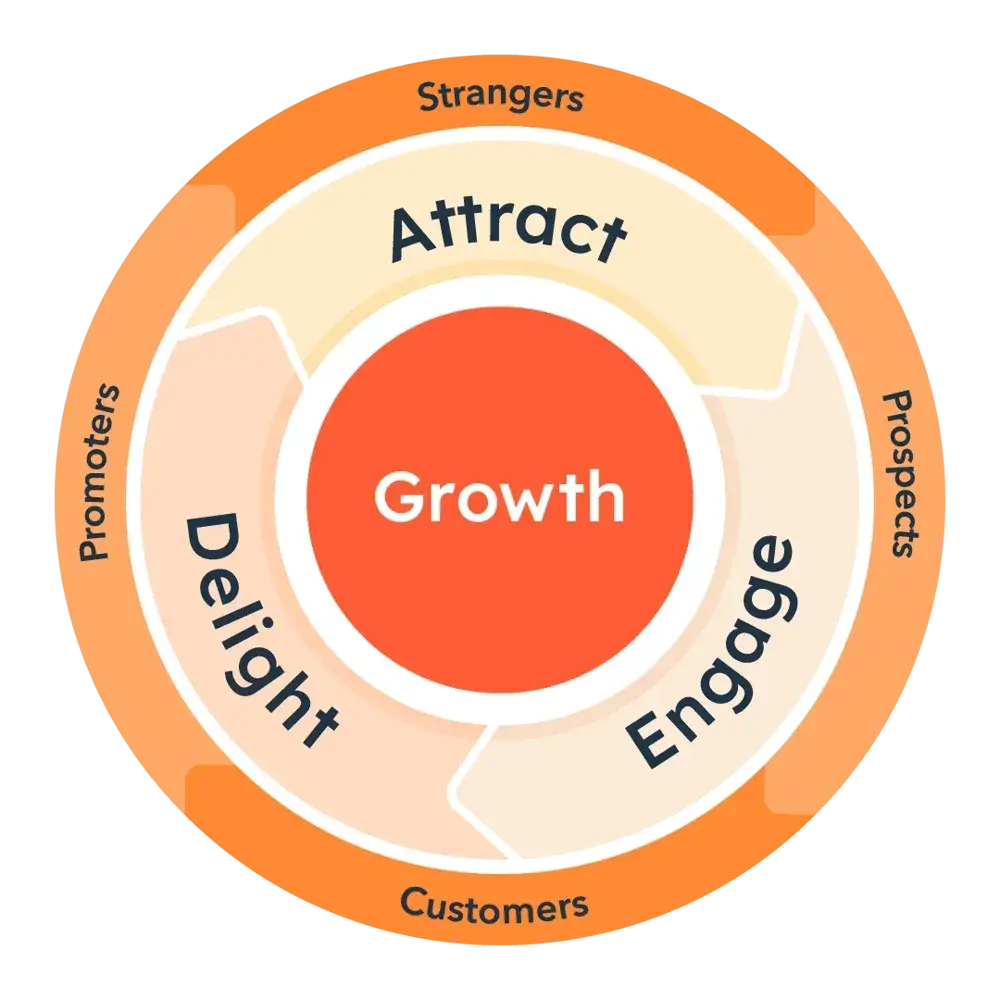
All teams play a role in the inbound process. Your marketing and service teams drive the “attract” stage that draws customers to your business. The marketing and sales teams then “engage” the lead and motivate them to convert. Finally, the sales and service teams complete the flywheel by delighting the customer with a great purchase and fantastic customer support.
Sounds simple enough, right?
Well, not quite. Take it from me: In a truly successful inbound organization, customer delight is everyone’s responsibility — not just that of the people your customers may come into contact with after buying something from your brand.
The most successful inbound organizations encourage teams to collaborate to delight both current and potential customers. Of course, your customer service and support teams play a large role here, but so do all other customer-facing departments, such as marketing, sales, and product.
That’s because achieving real delight is only possible when you surpass customer expectations in every interaction they have with your business. From visiting your blog to checking out your website’s pricing page, chatting with a sales rep, or asking for help using your product, the customer should be delighted every single time they engage with your brand.
When you accomplish this, you’ll build strong relationships with your customers that inspire them to remain loyal brand advocates and promoters.
Now, at this point, you might be thinking, this sounds a lot like customer satisfaction. But in fact, customer delight and customer satisfaction are two very different things.
Customer Delight vs. Customer Satisfaction
Customer delight is the process of surpassing customers’ expectations to build a long-term, positive experience around your product or service and brand. In contrast, customer satisfaction happens when you simply meet customers’ expectations.
While satisfied customers are certainly good for your company, delighted customers are more likely to become loyal, long-term brand advocates. In today’s competitive business world, delighting your customers — rather than simply satisfying them — is critical to your success.
Why is that? Well, in my experience, not only are customer expectations tougher than ever, but their recommendations to their personal and professional networks can also be the difference between your business growing and floundering.
Today, it’s easier than ever for your customers to find a new product or service if yours fails to meet (and exceed) their expectations. They can also easily share their experiences publicly by publishing feedback about your business on platforms such as Facebook, Yelp, and Google Reviews — and if that feedback is negative or even just neutral, it can be seriously bad for business.
At the end of the day, most businesses quite literally can’t afford to ignore the importance of retaining customers by offering a delightful customer experience. After all, for every customer you lose, you’ll have to attract a new one … and that’s usually much more expensive than simply doing what it takes to keep existing customers coming back for more.
Ultimately, I’ve learned that successful inbound organizations don’t just focus on getting a customer’s business and meeting their basic needs. Instead, they aim to provide an all-encompassing, truly remarkable customer experience that will generate delight. So, let’s take a look at the factors that make a delightful — not just satisfying — customer experience.
How to Delight Your Customers
- Provide timely, almost instant support.
- Clearly publish company contact information.
- Offer each customer a personalized experience.
- Give loyal customers preferential treatment.
- Treat customers like people, not numbers.
- Solve (potential and current) customers' problems.
- Solve for the present and the future.
- Help customers succeed.
- Listen to customer feedback.
- Be enthusiastic.
- Be unexpected.
- Build a community.
1. Provide timely, almost instant support.
A critical component of customer delight is the ability to be available and responsive whenever your customers reach out. Whether the issue is big or small, make sure to demonstrate to your customers that you’re always prioritizing them by responding quickly.
Even if you can’t solve the issue right away, let them know you’re working on it or escalating it to someone who can help. This will show them that even if you don’t have the answer immediately, you are serving as their advocate.
In addition, I’ve found that adopting a customer relationship management software, or CRM, is a great way to manage interactions with your customers. With a CRM, you can record and log all emails and other forms of communication. You can also set up reminders to follow up with specific clients on various issues, helping you to respond promptly every time.
These software tools can set your business up to engage in conversational marketing and sync across your customer service cases, allowing you to keep all your communications aligned and provide a more delightful customer experience.
Furthermore, whether customers meet you in a brick-and-mortar store or visit an online SaaS platform to buy your products, they will want to feel like if they need help, they can get it immediately. Your staffers or reps don’t necessarily need to approach the customer first, but they do need to be accessible to help customers resolve small, one-time issues as soon as they come up.
For an online business, this may mean adding a live chat function to your website, with either an AI chatbot or a human on the other side. I also always recommend thinking carefully about the pages where the live chat widget will be most useful.
For example, a home page visitor might not have many questions, but someone visiting the pricing page might — so it may be more useful to the customer if you include the widget on the pricing page rather than on the home page. For example, check out how the HubSpot website includes a chat widget on its pricing page:
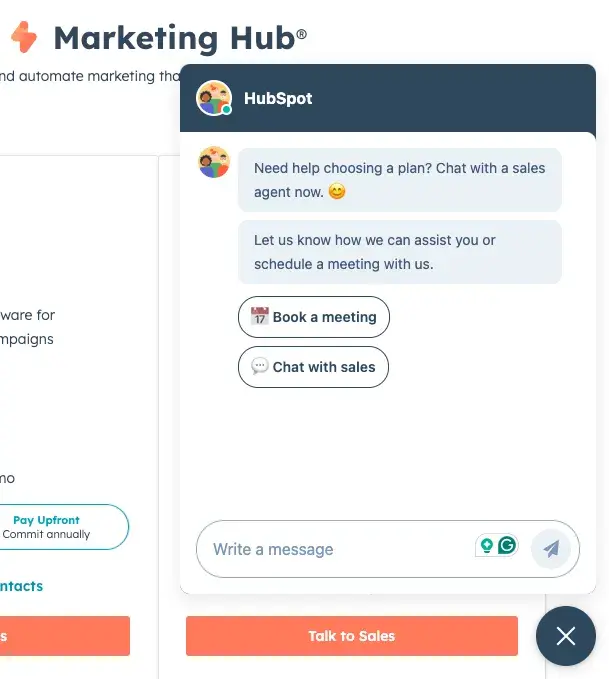
In contrast, for a brick-and-mortar store, you might have several clerks on the floor, ready to assist if needed. Importantly, these should not be sales reps in disguise, trying to make a sale and push the customer toward a purchase decision. Instead, they should just be available in case the customer wants a certain item or has a quick question.
2. Clearly publish company contact information.
Imagine that you’re a customer who needs help with their order, who needs to get a complicated question answered, or who simply needs to get in touch with a human. When you need help, there’s nothing worse than having to dig and dig for a company’s contact information or feeling like the company is doing everything possible to avoid having to speak with you.
To keep customers delighted, you should make it easy for them to get in contact with you. Even more importantly, they should have several avenues for reaching you, such as email, phone, social, and chat. This is more than just offering an answer to a one-time question. If a customer is reaching out directly to your team, they likely require extended help and support on bigger issues.
In addition, you should also strive to provide two different contact avenues for customers and non-customers. For instance, I love Zendesk’s approach to offering dedicated customer and non-customer contact options:
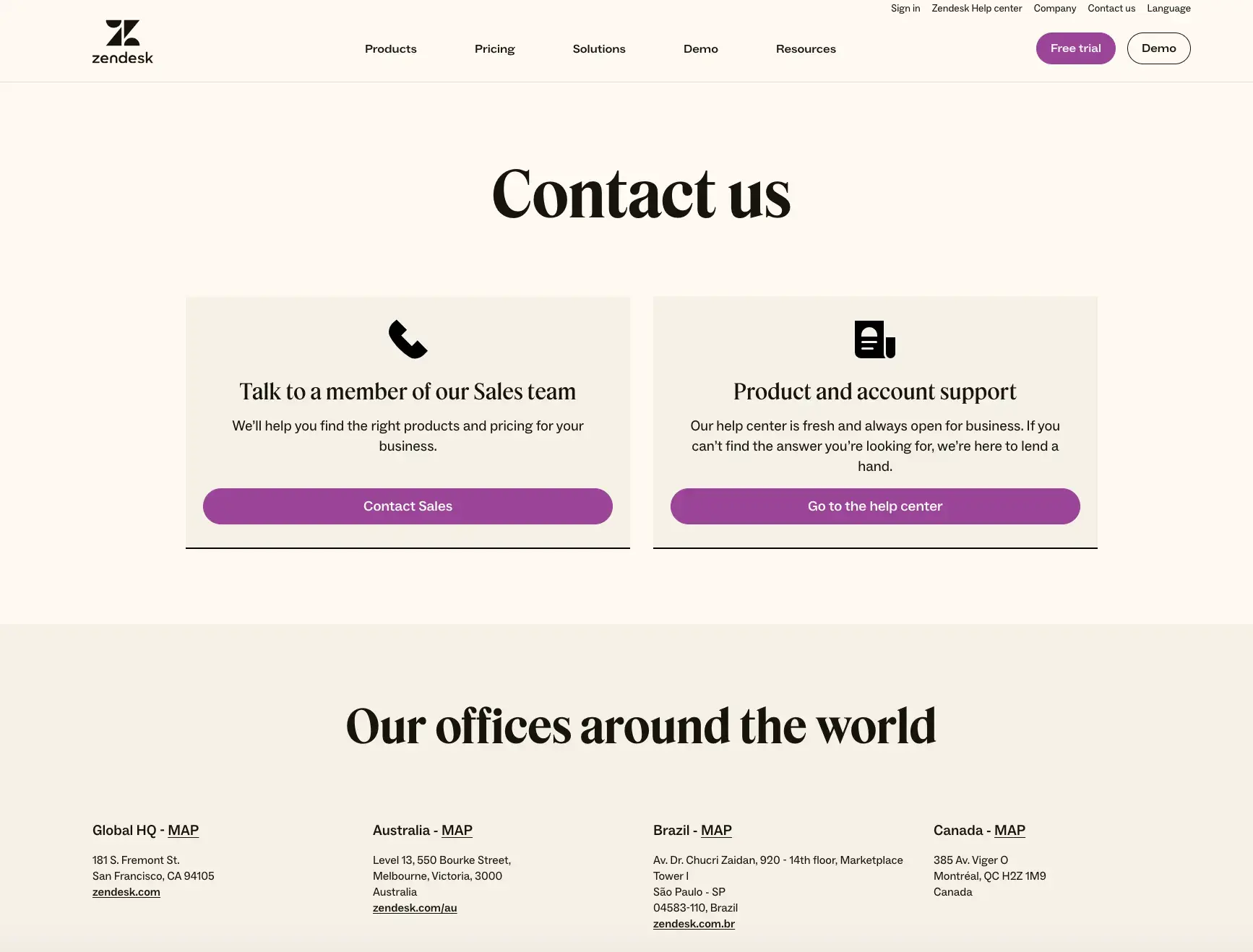
With this interface, non-customers are prompted to talk to a member of the sales team, while those who need support with Zendesk’s products and services are prompted to go to the help center.
Pro tip: Consider using a knowledge base software so your customers can troubleshoot their product issues on their own.
But Zendesk doesn’t stop there: It also allows visitors to get in contact with Zendesk offices around the world. There’s no attempt to hide each office’s contact information — it’s all right there on their main contact page.
3. Offer each customer a personalized experience.
I can’t overstate the importance of personalizing the experience for each customer. Addressing customers by their names in each email, sending offers that address their specific pain points, pitching them the specific products that they actually need — seemingly small gestures like these make customers feel like you’re trying to help them, not just sell to them.
You can start by providing a personalized experience through your website. For instance, if you’re an ecommerce retailer, you might only recommend products that are related to the user’s browsing history.
For instance, after I looked up a pair of Dr. Martens boots on Amazon, this was on my homepage the next day:

Amazon doesn’t stop there. When you first sign in to your account, you’re presented with a fully customized homepage, including a “Pick up where you left off” page where Amazon resurfaces products you’ve searched for recently. As a customer, this is the kind of personal touch that can make the difference between being satisfied and truly delighted.
Pro tip: On your journey to delight customers, be sure to speak to people’s unique needs and interests at every step.
4. Give loyal customers preferential treatment.
A loyal customer is a gold mine. Not only are loyal customers more likely to recommend your business to others, but they are also much less likely to churn themselves. As such, it’s important not to take them for granted.
Of course, your most loyal customers might not expect much. They likely already enjoy the products you sell and the experiences you offer — that’s why they’re so loyal to you. But, you can easily surpass their expectations and generate customer delight by offering them perks, discount codes, and long-term benefits.
One of my favorite ways to delight customers is through a strong customer loyalty program. A solid loyalty program can make your customers feel appreciated while also securing their future business. Ulta’s Beauty Rewards program, for instance, encourages customers to keep shopping by offering points on every purchase they make.

There are many different ways to set up a rewards program, but the most important element is just to show your loyal customers how much you appreciate them. If your loyalty program does that, you’ll be on your way to exceeding their expectations and delighting them.
5. Treat customers like people, not numbers.
It’s easy to look at customers in terms of profit. How much repeat business are they driving? How much are they worth in terms of monthly recurring revenue? While these metrics can be a great way to measure customer satisfaction, they can also sometimes prevent us from seeing customers for what they really are: People with their own unique problems and goals.
I’ve learned firsthand that customers don’t want to feel like the companies they buy from see them as nothing more than dollar signs. They want to feel like brands are offering solutions that help them with their problems and goals. As such, if you fail to treat customers like three-dimensional people first and foremost, then you’ll struggle to create a delightful experience.
The first place where you should make it clear that you’re trying to help is on your homepage. For example, on HubSpot’s homepage, the company speaks to its customers’ needs with the headline, “Grow better with HubSpot.”
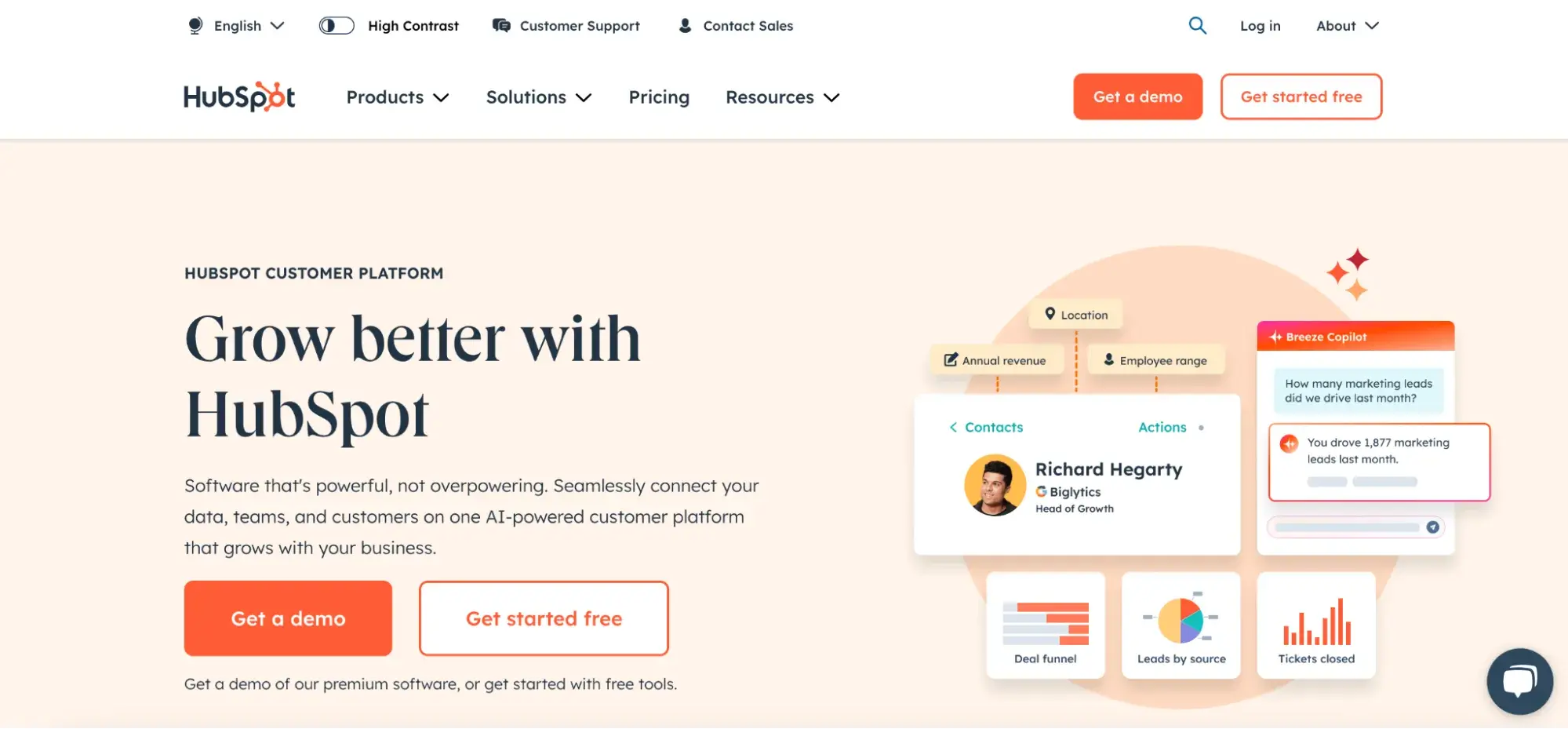
Compare that to a headline such as “Buy the best CRM platform right now.” A headline like that would make the customer feel like HubSpot is just trying to get something from them — not trying to offer them a product that will make their life easier.
Beyond your homepage tagline, here are a few of my personal top tips for creating a more “human” experience:
- Create a customer code. A customer code is a list of tenets that drive your business values and your customer interactions. Check out HubSpot’s customer code for inspiration.
- Don’t upsell or cross-sell the customer unnecessarily. Avoid upselling and cross-selling unless a more expensive product will legitimately help the customer reach their goals. Keeping prices reasonable — and even helping customers save money — is a great way to delight them.
- Put a human face on your business. Customers want to feel like a human is on the other side, not an enterprise business with its own opaque goals. Don’t make it hard for customers to reach a real live person on your team.
6. Solve (potential and current) customers’ problems.
The first — and perhaps most important — thing your organization needs to do is to solve the problems your potential and current customers are experiencing. After all, your customers are coming to you because you’re offering a solution to a challenge they’re facing or a way to achieve a goal they’re working toward. So don’t leave them hanging! Provide your customers with solutions that align with their individual wishes, needs, and preferences.
The same goes for prospects and potential customers. Even though they aren’t paying customers (yet), potential customers also need you to solve their problems.
In addition, beyond simply solving potential and current customers’ problems, you can take it a step further by empowering them with educational resources, recommendations, and tools for success in building your brand’s inbound experience.
Pro tip: You can empower your customers by writing helpful blog posts, sharing tips on social media, and creating a self-service knowledge base.
For example, HubSpot Academy provides free inbound and product lessons for all of HubSpot’s customers. The benefits of enabling people to reach their goals and solve their problems on their own time (instead of just arming them with facts or expecting them to wait around for service and support) are far-reaching, for both your organization and your customers.
7. Solve for the present and the future.
Of course, as a marketer, I’m not just interested in solving my customers’ problems in the short term. On the contrary, I’m always thinking ahead to anticipate their future needs, too.
As HubSpot Senior Customer Support Specialist Kahla Pruett explained to me, “A particular factor I like to keep in mind when solving for the customer is anticipating how tools and features related to the focal point of their case will be impacted when making any changes. From my experience, solving their current case and preventing new cases from being created absolutely delights the customer.”
I couldn’t agree more with Pruett. Going beyond the immediate solution to provide information and ways to help customers manage their challenges — and, if possible, teaching them to do so on their own — is critical to ensure you consistently delight the customer.
8. Help customers succeed.
Over the course of my career, I’ve seen time and time again that understanding why people are buying my company’s product or service is essential to determining how I can most effectively help them succeed.
Indeed, as Pruett shared, “When troubleshooting a case, I always begin the conversation by clarifying the customer's goals and determining how to solve for them in a way that not only addresses their present case, but prevents similar cases occurring for them in the future.” When you truly understand what it is that people need from a product or service like yours, you’ll be able to target those pain points and solve for them to exceed customer expectations.
Pro tip: Creating buyer personas or mapping the customer journey are great ways to build your understanding of why people need your product or service.
Download free templates to learn how to research and create buyer personas for your company.
I’ve also learned that it’s important to innovate constantly on your products or services, processes, and the overall customer experience. After all, it’s only by constantly improving that you can ensure you’re continuously delighting people.
This innovation can be large-scale — like launching a new product or business model. It can also be on a smaller scale, like making a minor change in the way you train new employees to handle customer questions.
You can also help customers succeed by providing them with high-quality educational materials via multichannel customer service (e.g. chatbots and social media), a self-service knowledge base, and/or a blog. These resources should provide customers with the information they need to reach out to your service and support teams, to get the help they want and require, or to look for answers to their questions on their own.
9. Listen to customer feedback.
I know that it can be tough to hear critical feedback. But I also know that constructive feedback can make the difference between a business succeeding or falling behind.
Your customers are paying to use your product or service. So, when things break or go wrong, they want their inconvenience to be understood and acknowledged with empathy (and maybe even with a discount or kind note thanking them for their patience, too).
In my experience, an automated software solution can be really helpful when it comes to effectively collecting and managing customer feedback. For example, HubSpot’s customer feedback software allows you to create and customize surveys that can be linked to a customer’s individual record in the CRM. This gives your customer service team time to research a specific customer’s history with your company and come up with an effective response before reaching back out.
10. Be enthusiastic.
When I think about my own interactions with companies, I rarely think twice about dull, predictable experiences. But when a barista or shopkeeper greets me with enthusiastic energy, I remember that business for a long time!
In every interaction your business has with potential and current customers, it’s critical to maintain an enthusiastic, positive, and welcoming voice that complements your brand. Of course, precisely what this sounds like (or looks like) for your organization depends on your particular brand, industry, and image. What matters most is to display authentic, consistent enthusiasm.
More than just offering customers a positive experience, employee enthusiasm can also be an indicator of a positive company culture in which workers feel supported — and that’s something many modern-day customers may consider when choosing which businesses they’ll support.
At the end of the day, if you want to create an inbound experience that truly delights, don’t be a robot. Instead, provide real, warm, personalized, human interactions that respect your users’ time and leave them happy, satisfied, and educated.
11. Be unexpected.
If you want your company to stand out from the competition, then you need to make a lasting impression on your customers. While your primary goal should always be to solve the customer’s problem, you can create a memorable experience by giving customers more than they ever anticipated.
Customers expect to see their needs fulfilled — but they’ll be truly delighted when your team goes above and beyond to surpass those expectations with an unexpected, positive experience.
Pro tip: Exceed your customers’ expectations by personalizing each interaction and ingraining a customer-centric culture into all parts of your company.
For example, I love using personalization software in my emails and on my web pages to make content feel like it was designed for each individual user and visitor. By creating one-of-a-kind customer experiences, any business will have a better chance of surpassing customer expectations and improving overall customer loyalty.
12. Build a community.
Everyone enjoys feeling like they belong to a community or group. As such, your company can cultivate this positive feeling by creating and supporting a welcoming user community.
Your customer community might serve as a resource for sharing useful information, or it might act as a medium for users to submit reviews. No matter what your community’s function is, fostering a space where customers can interact with one another — and perhaps even with your employees — can add value to both you and your customers.
For example, if a customer is considering a purchase, they may ask a question in the community or read through past reviews in the community’s forum. Access to other people’s experiences and recommendations can inform their own opinions, making them more confident moving forward with your business.
Clearly, there are lots of ways to delight your customers. But what does all this look like in practice? Below, I’ve shared some of my favorite examples of businesses putting these principles of customer delight into action.
Customer Delight Examples
- HubSpot
- Patagonia
- Sephora
- Delta
- Chewy
- LEGO
- Starbucks
- Trader Joe’s
1. HubSpot
One of my favorite examples of a company intentionally prioritizing customer delight is HubSpot. HubSpot transitioned from a traditional funnel approach to a flywheel model specifically in order to drive growth and delight customers.
By aligning the entire organization around delivering a remarkable customer experience, HubSpot is able to foster deeper relationships with customers at every stage of the buyer’s journey. This results in happy customers who drive referrals and repeat sales.
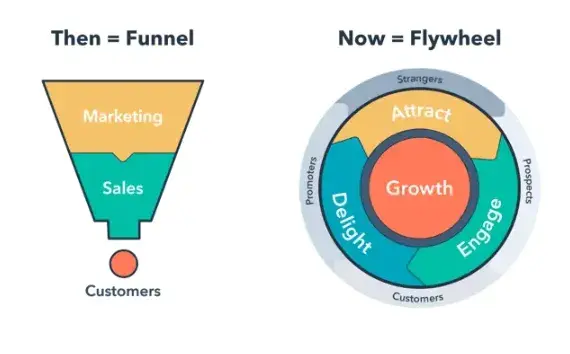
HubSpot’s customer service teams, sales reps, growth specialists, marketers, and all other teams are trained to exceed customers’ expectations and solve for their pain points and challenges.
Additionally, the HubSpot Community, HubSpot Knowledge Base, HubSpot Academy, and HubSpot Blog all offer HubSpot customers a place to communicate with each other, learn from the various available resources on their own time, and get immediate answers as needed.
Finally, all HubSpot products are made to grow with customers as their businesses evolve, with teams of engineers working to ensure products are constantly updated to meet customers’ ever-changing needs.
2. Patagonia
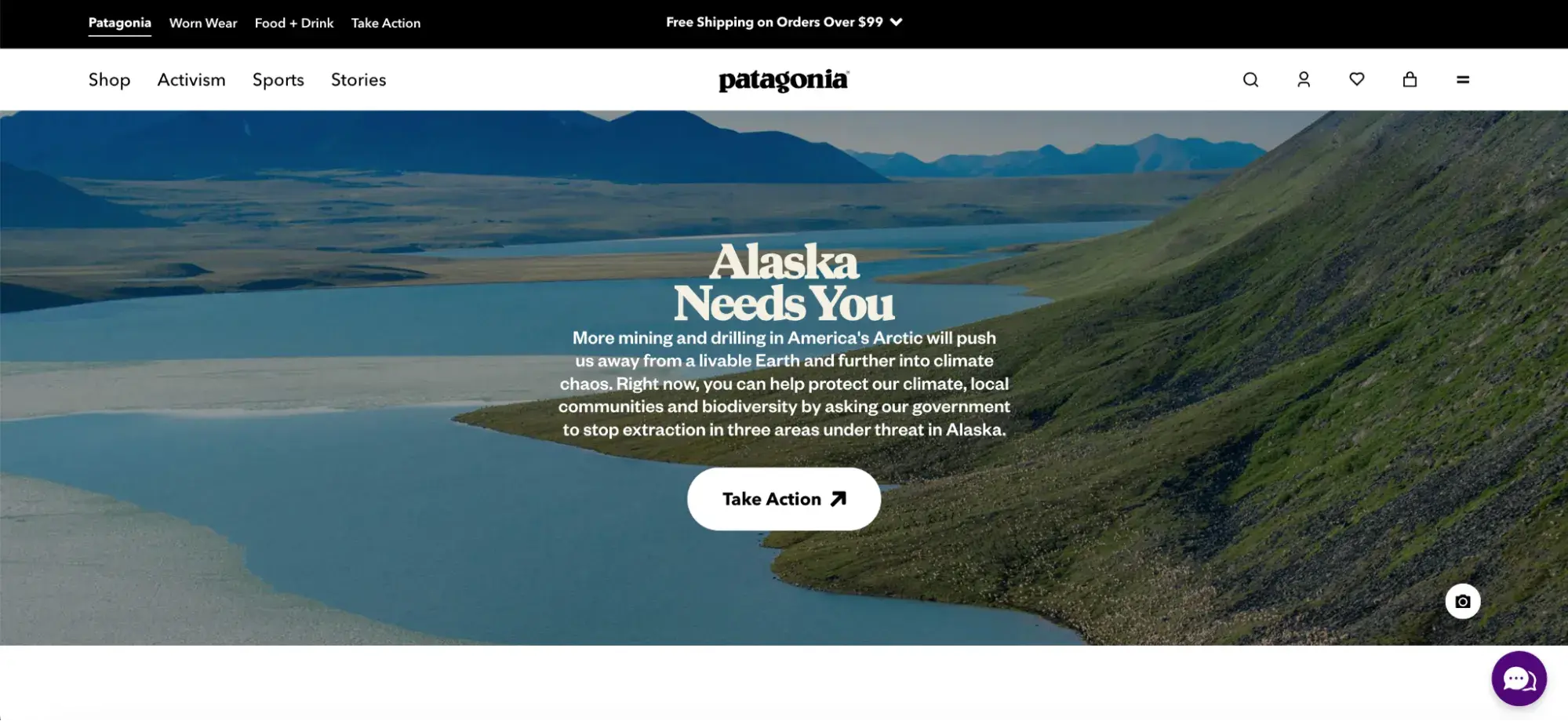
Another one of my favorite examples of customer delight is Patagonia. Known for its commitment to protecting the environment, Patagonia delights its outdoors-loving customers in countless ways.
Indeed, the brand is known for both its impeccable end-to-end service and its support for a range of sustainability initiatives. On the service front, Patagonia delights its customers with its Ironclad Guarantee: a unique policy whereby anyone who isn’t completely satisfied with a Patagonia purchase can easily repair, replace, or return their product.
At the same time, on the environmental front, Patagonia engages in many sustainability efforts and reduces waste by promising to repair any product — no matter how long ago it was purchased. The company proactively invites customers to participate in its repairs program in brick-and-mortar stores, through customer service (online and by phone), and with its Worn Wear program.
3. Sephora
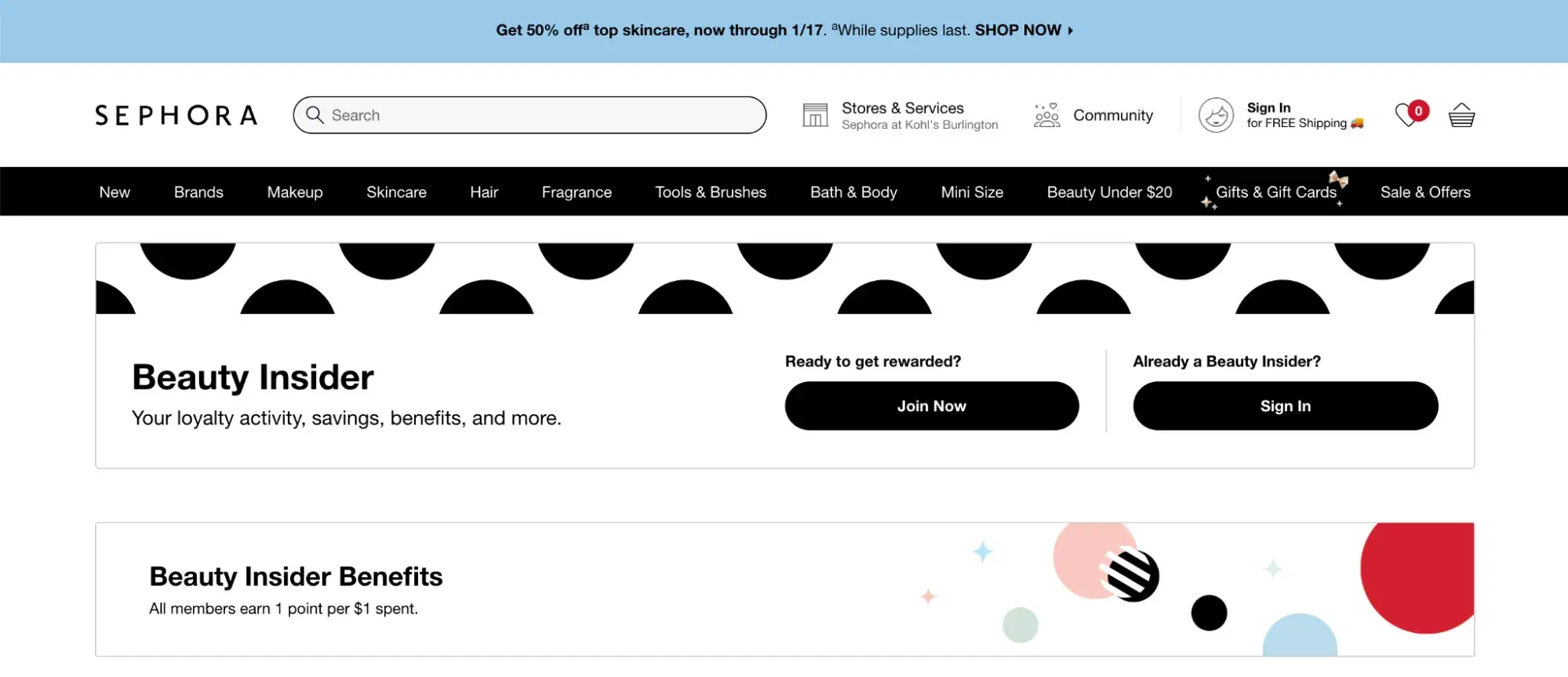
The global cosmetics, beauty, and fragrances company Sephora uses a wide range of marketing and service programs to delight its customers.
For example, Sephora’s Beauty Insider loyalty program provides customers with a wide range of benefits, from in-store beauty services and free beauty classes to access to the company’s Insider Community and even a free birthday gift. This rewards program turns customers into advocates, and it keeps them coming back for more.
Additionally, Sephora markets many of its product lines by offering services to help customers find the products that will be the best fit for their unique needs. These services include in-store experimentation, personalized consultations and marketing materials, and tutorials on social media.
In this way, the company helps its customers choose the best possible products to address their specific beauty goals, ensuring a delightful experience every time.
4. Delta
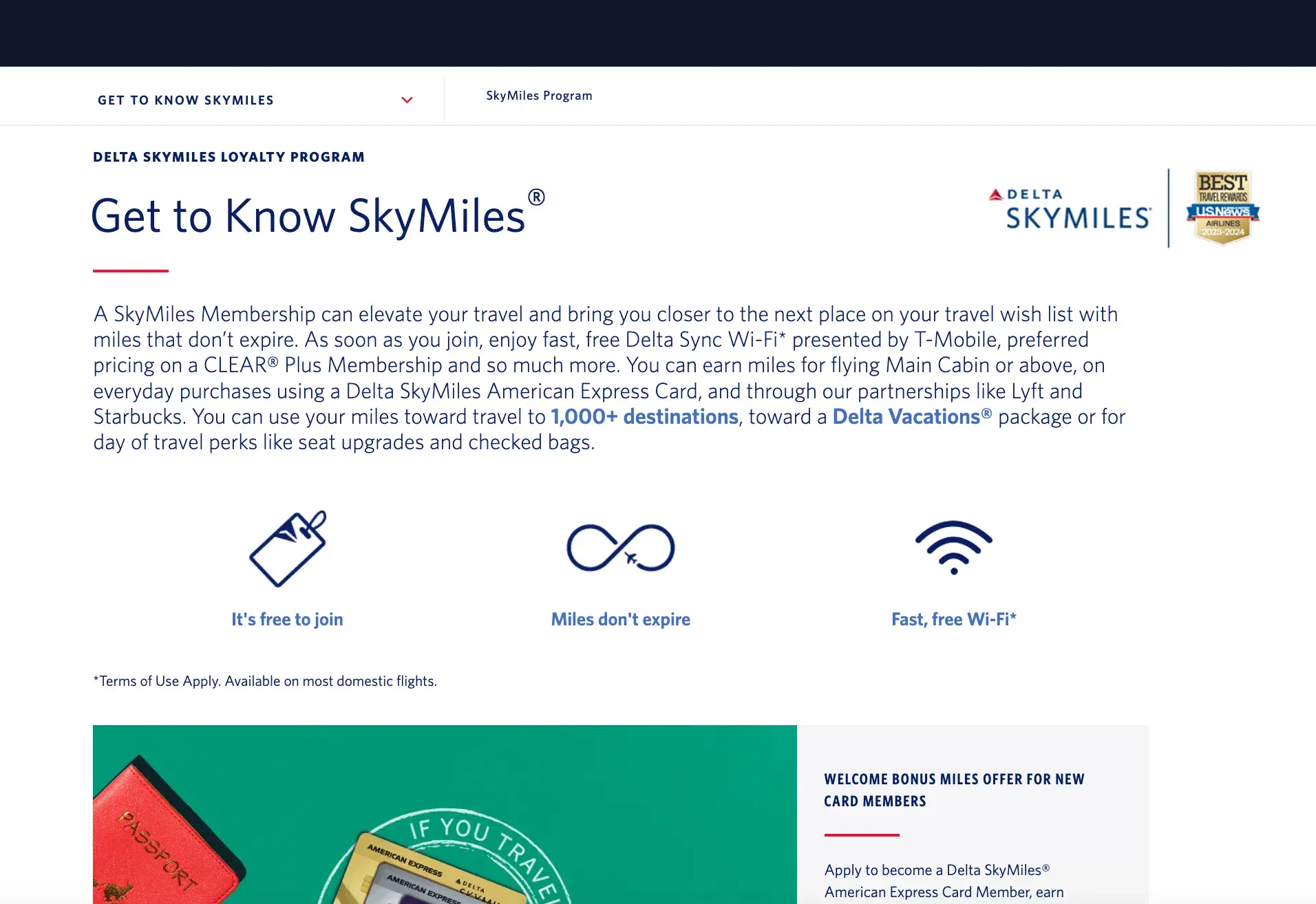
When I think of air travel, I generally think of long lines, delayed flights, and cramped seats — not exactly a delightful experience. But Delta has taken steps to overcome these negative preconceptions, surpassing flyers’ expectations and delighting customers on a consistent basis.
Specifically, Delta’s SkyMiles program is known in the industry as the best of its kind. The more you fly with Delta, the more miles you earn … and the more free flights you can redeem later down the line.
The airline also offers luxurious lounges for its Sky Club members. Moreover, even if you’re only a SkyMiles member, that’s no problem — you can still access the amenities for a fee. Through programs like these, Delta consistently exceeds expectations by striving to provide a comfortable (and even delightful) experience both on and off the plane.
5. Chewy
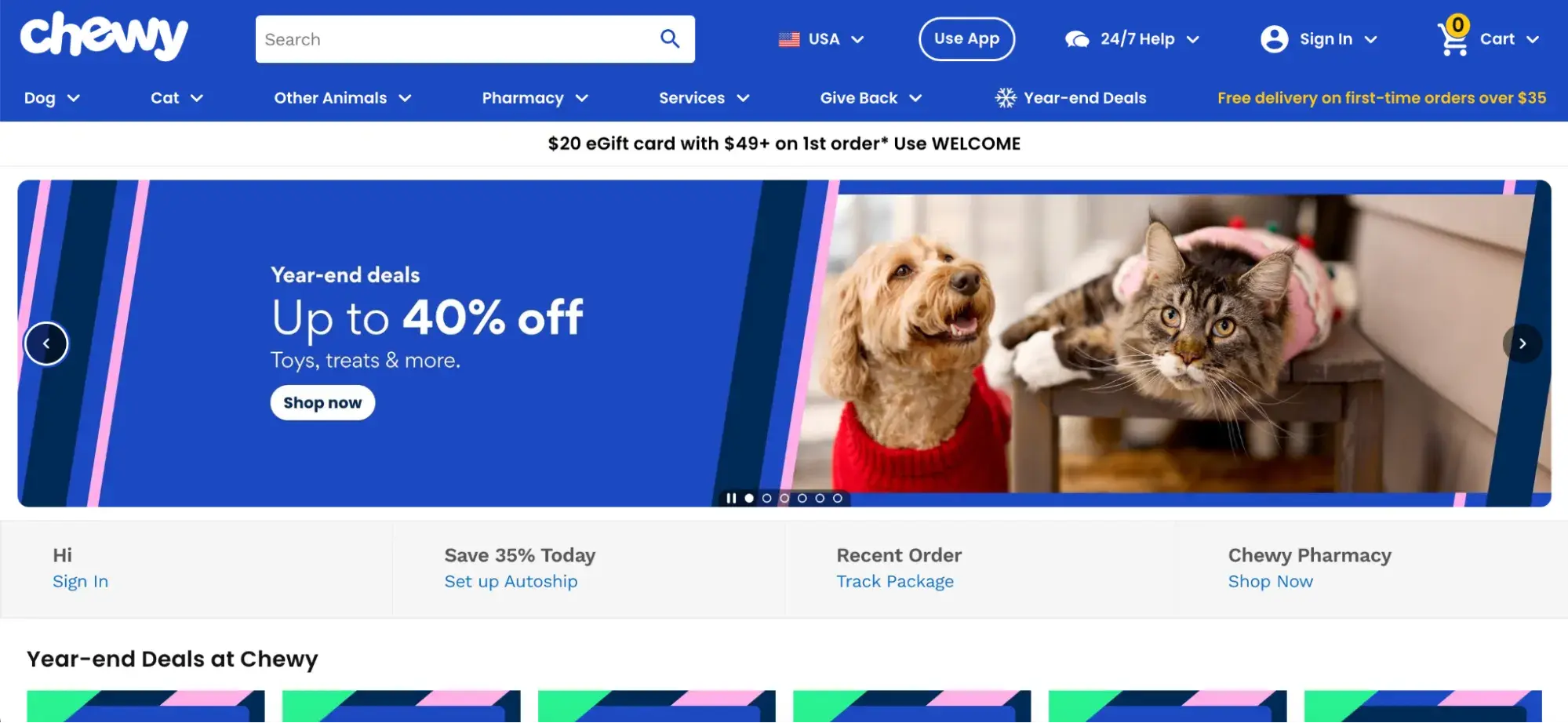
As a proud pet owner myself, Chewy is a company that’s always had a special place in my heart. In all of its communications and initiatives, this pet supply retailer openly shares its desire to offer customers delightful experiences. The organization does so with its many subscription offerings, 24/7 customer support (available via multiple channels, including live chat), and being a one-stop shop for pet supplies.
Chewy also makes sure to go above and beyond with all of its direct customer interactions (even though it’s a large company with a massive customer base). For example, when customers have canceled their Chewy subscriptions due to their pets passing away, they have reported receiving flowers and handwritten notes from Chewy employees sharing their condolences.
While other companies might carelessly treat these customers as “churn,” Chewy takes a different approach: One Reddit user reported that Chewy even sent them a portrait of their pet after their pet died.
Recently, Chewy instituted yet another delightful program: The company invited its customers to submit letters to “Chewy Claus” with holiday requests for pet food, toys, and other supplies.
Explaining the importance of this initiative, Chewy’s VP of Brand Marketing Orlena Yeung shared, “At Chewy, we know pets are a part of the family and we wanted to give them a way to truly participate in the holiday season this year.” She continued, “Through Chewy Claus, we are hoping to spread joy while recognizing the most important gift that keeps on giving — the love and companionship of our pets.”
Talk about creating a delightful experience for customers, human and animal alike!
6. LEGO
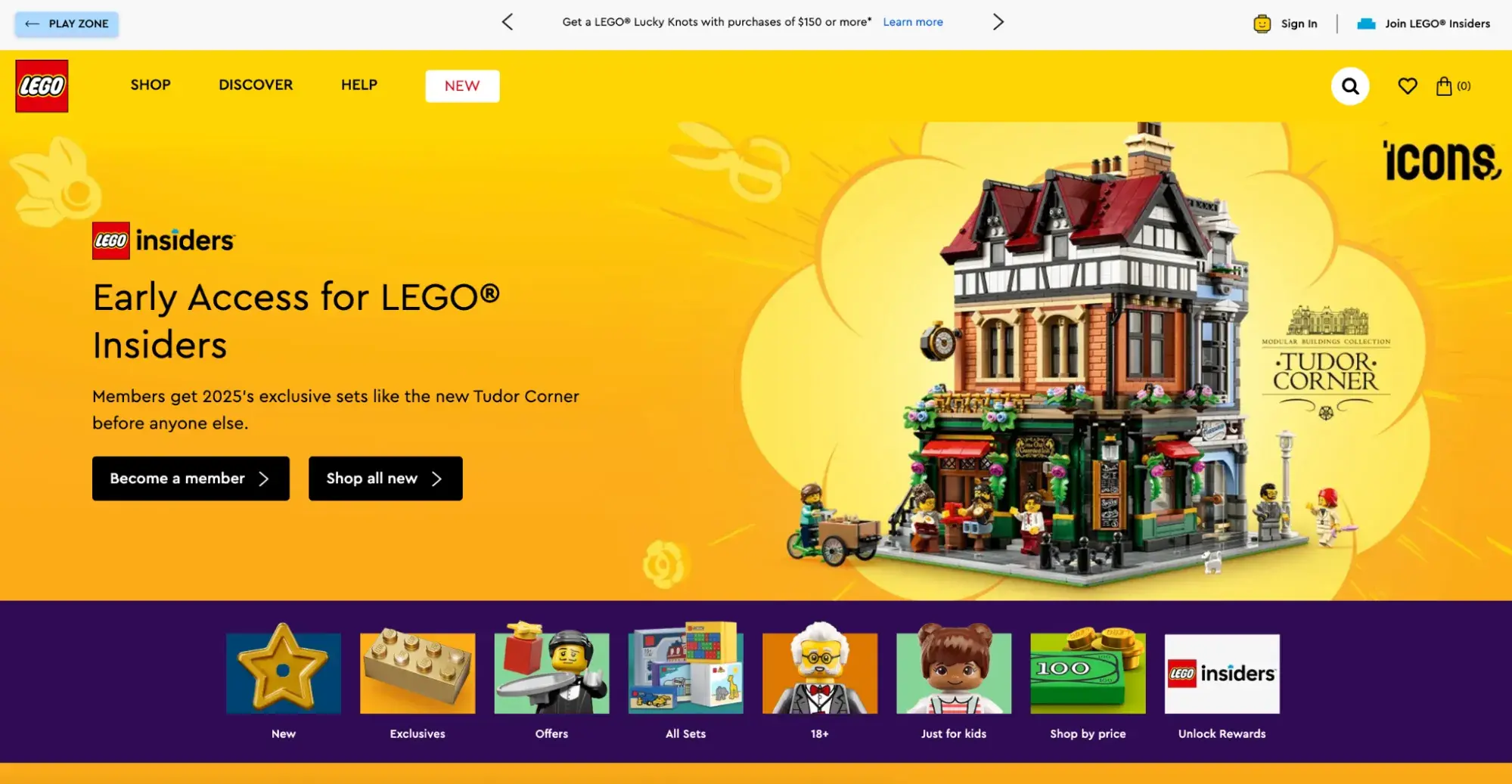
Another company I’ve long had a soft spot for, LEGO makes a point of transforming each and every customer interaction into a delightful experience.
For example, even its 404 page is entertaining: Rather than a standard “Page not found,” the LEGO 404 page shows a Lego character with the comical tagline “OH BRICKS! We can’t find this page. We’ll try not to lose our heads over this, but if we do … we’ll put it back on.”
LEGO also offers a loyalty program known as LEGO Insiders, in which members get exclusive access to new sets. And in recent years, LEGO even started producing Braille LEGO bricks, so that visually impaired customers could enjoy their product along with their sighted friends. From new product launches to simple choices such as a 404 page tagline, LEGO consistently makes decisions optimized for customer delight — and it shows!
7. Starbucks

What could be more mundane than a cup of coffee in the morning? It may not seem like Starbucks is in a particularly delightful industry, and yet the coffeehouse giant’s commitment to “uplift the everyday” is evident in countless decisions the company makes.
On the product front, Starbucks offers many forms of customization so that every customer can get their drink made exactly how they want it. The company is also known for encouraging baristas to welcome every customer with a smile and to address customers by name for a more personalized experience.
In addition, small touches on the Starbucks website offer moments of delight. For example, its cookies notice includes the fun tagline, “This site uses cookies, but not the kind you eat” — a playful reference to the sweet treats the company sells.
Starbucks also offers a rewards program that includes a free drink as soon as you sign up, as well as other enticing rewards and perks. In all these ways, Starbucks makes a point of transforming a simple daily purchase into a consistently delightful experience.
8. Trader Joe’s
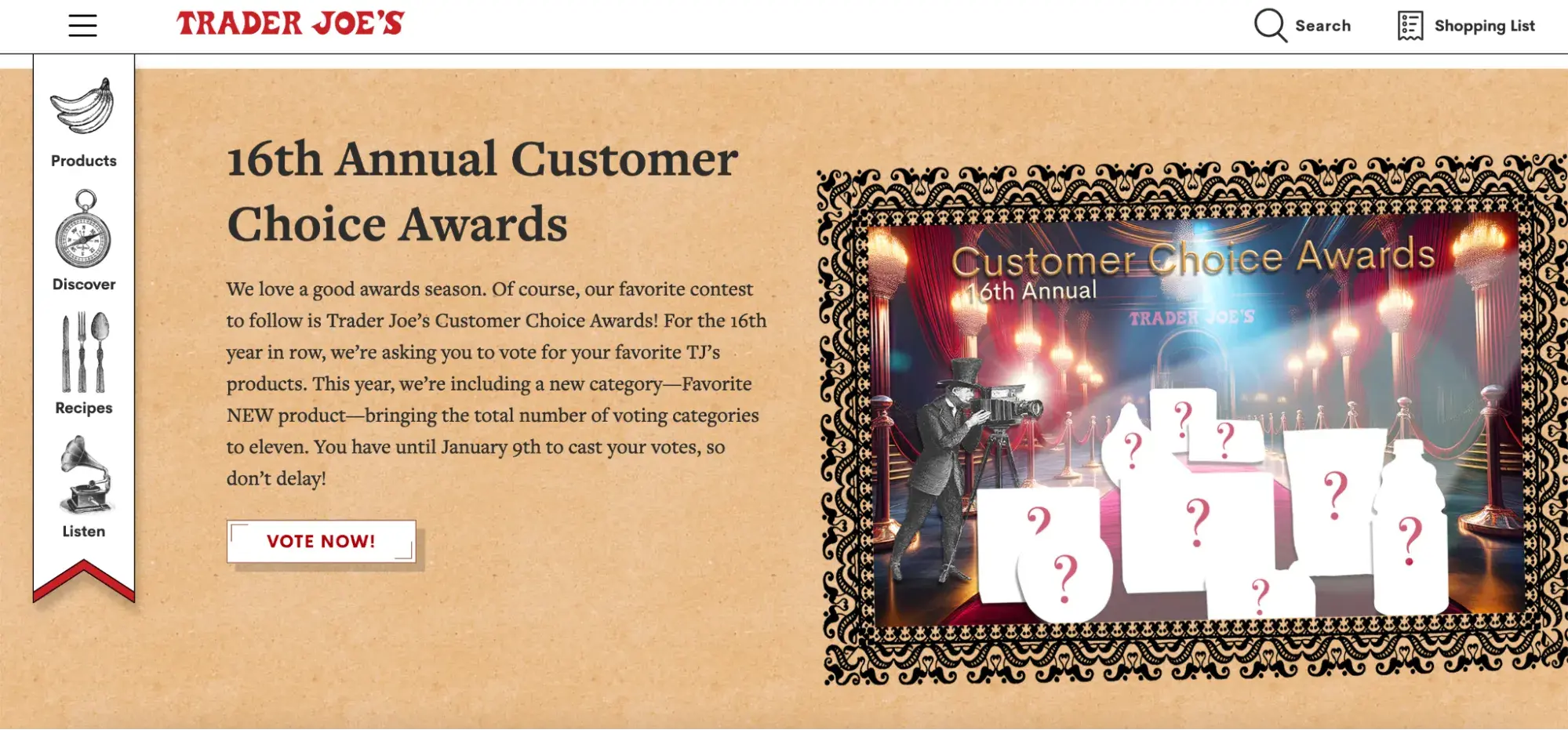
Finally, I would be remiss if I didn’t include one of my absolute favorite brands: the grocery chain Trader Joe’s. With a loyal following of die-hard fans, Trader Joe’s turns the ordinary chore of grocery shopping into an extraordinary, delightful experience.
From its clever in-store signage to popular store-brand product lines, Trader Joe’s makes food shopping fun. In addition, the company also prioritizes sustainability, cleanliness, and safety, taking steps to reduce food waste and ensure the health and wellbeing of its customers and staff members alike.
In addition, one of my personal favorite ways in which Trader Joe’s has prioritized customer delight is through its annual Customer Choice Awards. Highlighting its customer-centric ethos, Trader Joe’s invites its customers to vote on their favorite products across a range of categories.
This is both an opportunity for engagement and interaction with customers and an opportunity for the company to solicit feedback from its customers. In other words, it’s a clever strategy that both delights customers in the near term and gives the company the data it needs to delight customers in the long term, too.
Delight Your Customers to Grow Better
In my professional experience, delighting customers is a critical ingredient for any business to grow better. If you don’t implement these strategies, your business has a much larger chance of falling behind or getting lost among dozens (or hundreds) of competitors.
As such, it’s important to take the time to think about how you’ll delight your customers. Determine which tactics you want to experiment with, and look to the examples I’ve described above for inspiration. With a bit of work — and a lot of care — you’ll be on your way to creating an unforgettable experience that surpasses all expectations and truly delights your customers.
Editor's note: This post was originally published in January 2018 and has been updated for comprehensiveness.
Customer Delight
-3.png?width=112&height=112&name=support%20strategy%20cover%20(3)-3.png)

.png)
![10 Customer Onboarding Challenges You Might Face This Year [+Expert Tips]](https://53.fs1.hubspotusercontent-na1.net/hubfs/53/ai%20customer%20service%20predictions%20(2).webp)

.jpg)
